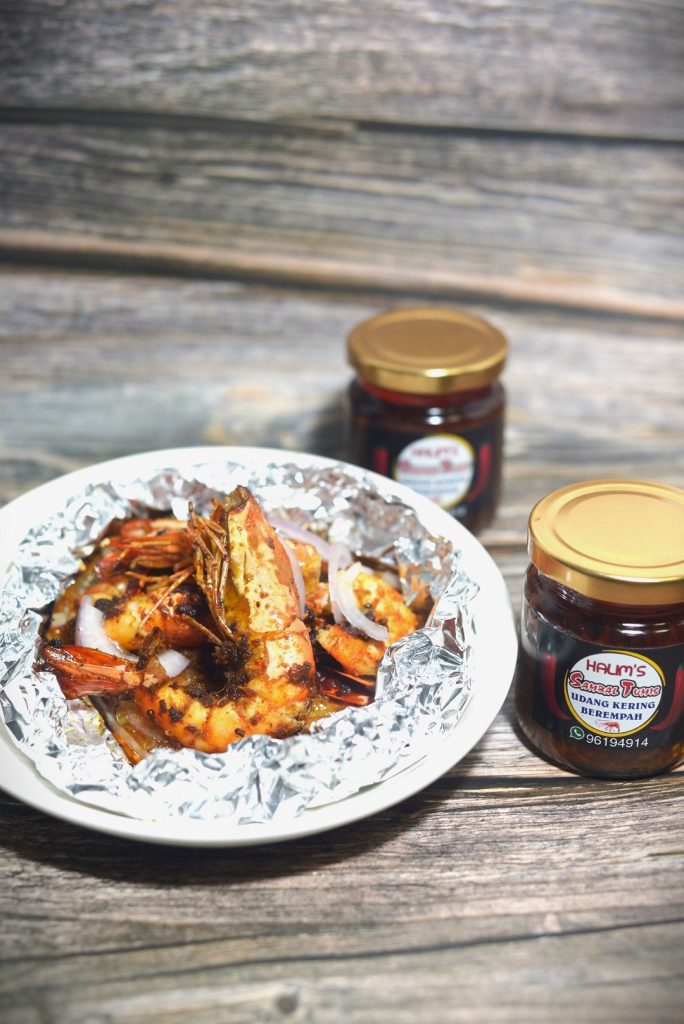
Introduction – Prawn Sambal/ Sambal Udang Sedap
If you love the fiery flavors of sambal and the crispy goodness of prawns, we have a treat for you. In this recipe, we’ll show you how to combine the two to create a mouthwatering dish that’s not only delicious but also guilt-free, thanks to the magic of the airfryer. Our Airfryer Prawn Sambal recipe brings together succulent prawns and the spicy punch of sambal, all while keeping things light and juicy. Let’s dive into the steps to make this delectable dish!
Ingredients for Prawn Sambal
4 Large Prawns
Halim’s Sambal Udang Kering
Onion Slice
Instructions to prepare prawn sambal
- Clean and peel the prawn shell
- Marinate with halim’s prawn sambal tumis berempah
- Aluminum Foil at bottom, layer on onion and follow by marinated prawn. Seal the prawn in the aluminium foil
- Airfry the prawn in the sealed aluminum foil for 18 Minutes,
- Open the Aluminum foil and the prawn is ready to eat. Bon appetite
Video
For all video
Conclusion
The Airfryer Prawn Sambal recipe is a fantastic way to satisfy your craving for spicy and crispy seafood without the need for excessive oil or deep-frying. This dish is perfect for those who enjoy bold, fiery flavors and the satisfying crunch of perfectly cooked prawns. Give it a try, and you’ll discover a new favorite recipe that’s both easy to make and incredibly delicious. Enjoy your crispy, spicy, and irresistible sambal prawns!
History and Story about Prawn Sambal
Sambal prawns are a quintessential part of the Southeast Asian culinary tradition, with a lineage that can be traced through the region’s diverse cultures. The term “sambal” refers to a spicy chili-based sauce or condiment used to enhance the flavors of a variety of dishes. Sambal is believed to have originated in the Indonesian archipelago, where chilies, a key ingredient, were cultivated.
Culinary Evolution:
The history of sambal prawns is deeply intertwined with the historical and cultural development of Southeast Asia. The dish showcases the diverse influences and vibrant flavors that have shaped the region’s cuisine.
Key Ingredients:
At the heart of sambal prawns is the mouthwatering marriage of fresh prawns and sambal sauce. Prawns, with their succulent meat, are an ideal canvas for absorbing the rich, spicy flavors of sambal. The sambal sauce is typically composed of a combination of chilies, shallots, garlic, and other spices, which are pounded or blended together to create a fiery paste.
Preparation and Variations:
Sambal prawns can be prepared in a multitude of ways. The prawns may be stir-fried in sambal sauce, grilled with a sambal marinade, or even simmered in a flavorful sambal-infused coconut milk broth. The variations of this dish are as diverse as the regions it hails from, with each community adding its unique twist.
Cultural Significance:
In addition to its delectable flavors, sambal prawns carry cultural and social significance. In Southeast Asian cultures, sharing a meal featuring sambal prawns is often a symbol of hospitality and community. The dish is a staple at celebrations, feasts, and gatherings, signifying the importance of coming together over a flavorful and spicy meal.
Modern Appeal:
Today, sambal prawns have not only retained their cultural importance but have also found a global following. The dish’s bold flavors, fragrant spices, and the fiery kick of sambal have made it a favorite among food enthusiasts worldwide.
Sambal Prawns in Contemporary Cuisine:
Sambal prawns have transcended cultural boundaries and can be found on restaurant menus across the globe. They have also been adapted and incorporated into fusion cuisines, adding a burst of excitement to international culinary creations.
The Enduring Allure:
Sambal prawns are not just a dish; they are an embodiment of history, culture, and a passionate love for bold flavors. Their spicy, aromatic profile continues to attract food lovers from all corners of the world. Whether enjoyed at a family dinner in Southeast Asia or savored at a trendy restaurant in a bustling metropolis, sambal prawns are a testament to the enduring allure of a dish that transcends time and borders.
In conclusion, the history of sambal prawns is a testament to the culinary artistry and diverse influences of Southeast Asia. This dish not only tantalizes the taste buds with its fiery and aromatic flavors but also weaves together the rich tapestry of a region’s cultural and social traditions. Sambal prawns are more than a dish; they are a culinary journey that invites you to savor the flavors of a vibrant and dynamic part of the world.
